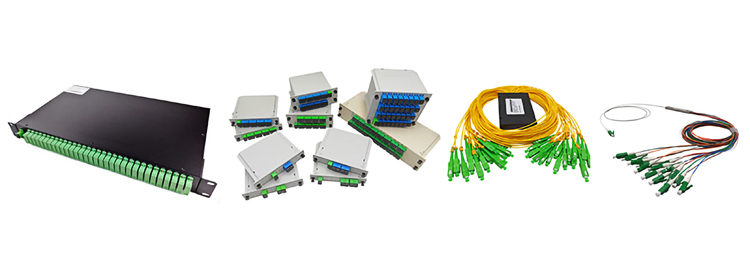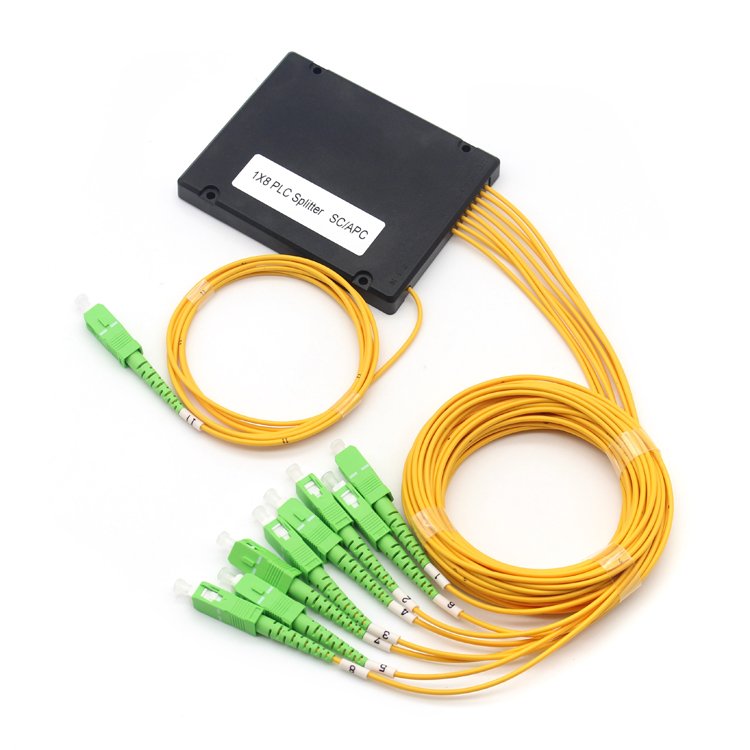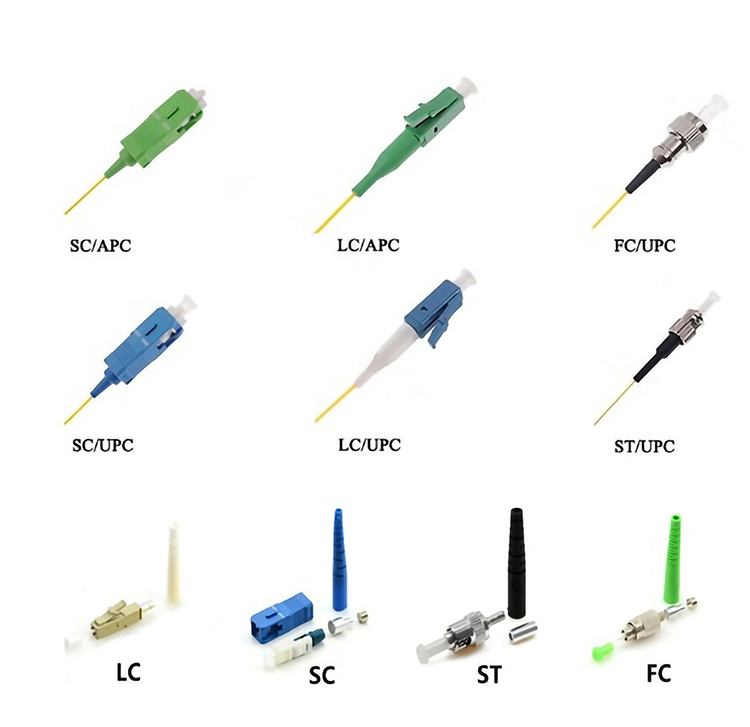
A fiber optic splitter is a passive optical device that divides a single optical signal into multiple outputs, enabling efficient signal distribution. These devices, including the plc fiber optic splitter, play a pivotal role in optimizing bandwidth by splitting signals into configurations like 1×2, 1×4, or 1×8. This functionality supports multiple users within a single network, making them essential in advanced networking.
The global demand for fiber optic splitters, particularly the multimode fiber optic splitter, continues to rise. Reports project the optical splitter market to grow from USD 1.2 billion in 2023 to USD 2.4 billion by 2032, reflecting a CAGR of 8.2%. This growth is driven by the increasing need for high-speed internet and the expansion of 5G networks. The plc fiber optic splitter, known for its precision and reliability, is especially critical in passive optical networks (PON) and other modern applications.
Key Takeaways
- Fiber optic splitters, such as FBT and PLC, share signals in networks. Knowing their differences helps you pick the right one.
- Picking the right splitter packaging can boost network performance. Choices like bare fiber, block, and rack-mounted fit different setups.
- Fiber optic splitters let one input connect to many outputs. This helps networks grow cheaply without big changes.
Types of Fiber Optic Splitters

Fiber optic splitters come in various types, each designed to meet specific networking requirements. Understanding their differences helps network engineers select the right solution for their applications.
FBT Fiber Optic Splitters
Fused Biconic Tapered (FBT) fiber optic splitters are among the earliest types of splitters. They use a simple fusion process to combine and taper optical fibers, creating a cost-effective solution for signal splitting. These splitters are widely used in less-developed regions due to their affordability and straightforward design.
FBT splitters exhibit higher insertion loss variability between ports compared to other types. Their performance metrics, such as return loss and directivity, range between 50-55 dB. However, they are more sensitive to temperature fluctuations, which can impact reliability in extreme conditions. Despite these limitations, their simplicity makes them ideal for rural networks where advanced technology may not be necessary.
| Type of Splitter | Description | Market Share Regions |
|---|---|---|
| Fused Biconic Tapered (FBT) | Simplicity and cost-effectiveness, popular in rural areas | Less-developed regions |
PLC Fiber Optic Splitters
Planar Lightwave Circuit (PLC) fiber optic splitters represent advanced technology in signal distribution. These splitters use semiconductor-based waveguides to achieve precise and uniform signal splitting across multiple ports. Their reliability and performance make them the preferred choice for urban networks and developed regions like North America and Europe.
PLC splitters outperform FBT splitters in several key metrics. They offer uniform insertion loss across all ports, with values typically lower than those of FBT splitters. Their return loss and directivity range from 55-65 dB, ensuring minimal signal leakage and higher reliability. Additionally, PLC splitters exhibit lower polarization-dependent loss (PDL) and wavelength-dependent loss (WDL), making them suitable for high-speed networks and demanding applications.
| Parameter | FBT Splitters | PLC Splitters |
|---|---|---|
| Insertion Loss | Higher variability between ports | Uniform loss across all ports |
| Return Loss | 50-55 dB | 55-60 dB |
| Directivity | 50-55 dB | 55-65 dB |
| Wavelength Dependence | Moderate to high | Relatively low |
| PDL (Polarization Dependent Loss) | Higher (0.2-0.3 dB) | Lower (0.1-0.2 dB) |
| Temperature Sensitivity | More sensitive | Less sensitive |
Fiber Optic Splitters by Packaging
Fiber optic splitters are available in various packaging options to suit different installation environments. Common packaging types include bare fiber splitters, block splitters, and rack-mounted splitters. Each packaging type offers unique advantages based on the application scenario.
Bare fiber splitters are compact and lightweight, making them ideal for installations with limited space. Block splitters provide better protection for the optical components, ensuring durability in harsh environments. Rack-mounted splitters are designed for large-scale networks, offering easy integration into data centers and enterprise systems.
Selecting the right packaging depends on factors like network size, environmental conditions, and installation requirements. For example, bare fiber splitters are often used in FTTH systems, while rack-mounted splitters are preferred in data centers due to their scalability and ease of management.
Features and Advantages of Fiber Optic Splitters
Key Features of FBT Fiber Optic Splitters
FBT fiber optic splitters are known for their simplicity and cost-effectiveness. These splitters use a fusion process to taper optical fibers, enabling signal splitting across multiple outputs. Their design supports a wide range of wavelengths, making them versatile for various applications. Recent testing highlights their durability under specific conditions. For instance:
| Item # | Coating Range | Damage Threshold |
|---|---|---|
| FBT-50NIR | 600 – 1700 nm | 6 J/cm² at 1064 nm, 10 ns, 10 Hz, Ø0.515 mm |
| FBT-50MIR | 1.0 – 6.0 µm | CW: 100 W/cm² at 2.1 µm, Ø0.027 mm; Pulsed: 0.5 J/cm² at 2.1 µm, 30 ns, 167 Hz |
| FBT-BSF-B | 650 – 1050 nm | 7.5 J/cm² at 810 nm, 10 ns, 10 Hz, Ø0.133 mm |
| FBT-BSF-C | 1050 – 1700 nm | 7.5 J/cm² at 1542 nm, 10 ns, 10 Hz, Ø0.189 mm |
These features make FBT splitters suitable for networks in less demanding environments, where affordability and basic functionality are priorities.
Key Features of PLC Fiber Optic Splitters
PLC fiber optic splitters offer advanced performance and reliability. Their semiconductor-based waveguides ensure uniform signal distribution, even at higher split ratios. This technology minimizes insertion loss and polarization-dependent loss, making it ideal for modern networks. Unlike traditional methods, PLC splitters maintain high uniformity in power distribution, which is critical for applications like 5G deployments. Their ability to split signals without degrading quality ensures seamless data transmission.
Additionally, the integration of AI and machine learning into PLC splitter design enhances their functionality. These innovations enable real-time performance monitoring and predictive maintenance, reducing downtime and operational costs. Service providers benefit from these features, as they improve network efficiency and reliability.
Advantages of Different Packaging Options
Fiber optic splitters come in various packaging options, each tailored to specific installation needs. Bare fiber splitters are compact and lightweight, making them ideal for space-constrained environments. Block splitters provide enhanced protection, ensuring durability in harsh conditions. Rack-mounted splitters, on the other hand, are designed for large-scale networks, offering easy integration into data centers and enterprise systems.
The choice of packaging significantly impacts network performance. For example:
| Feature | Contribution to Network Performance |
|---|---|
| Input/Output Port Configurations | Defines the number of signals accepted and paths created, minimizing signal loss and maximizing efficiency. |
| Insertion Loss | Good-quality splitters reduce insertion loss, ensuring uniform signal distribution across all ports. |
| Splitter Types (FBT vs. PLC) | PLC splitters provide better uniformity and reliability for higher split ratios, essential for modern networks. |
Selecting the right packaging ensures optimal performance, durability, and scalability, depending on the network’s requirements.
Applications of Fiber Optic Splitters in Networking

Fiber Optic Splitters in Passive Optical Networks (PON)
Fiber optic splitters play a crucial role in Passive Optical Networks (PON), enabling efficient signal distribution across multiple endpoints. These splitters ensure uniform signal splitting and maintain low insertion loss, making them reliable for high-bandwidth applications. Their high separation ratio allows a single optical line terminal (OLT) to connect to numerous optical network units (ONUs). This capability facilitates multi-user connections, enhancing the flexibility and scalability of PON networks.
Post time: May-01-2025
